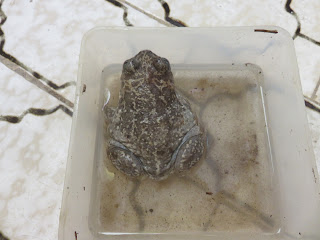Special report from Quinta do Conde for SAVE THE FROGS Day!
With my friend, fellow singer-songwriter Ana Lisa Meier, for this year's SAVE THE FROGS Day, we decided to create a report about frogs and wetlands in the Quinta do Conde area of Portugal where we are. Ana is very lucky because she has a colony of Iberian Water Frogs in her garden. They live in, and around, the two garden ponds, which shows how valuable ponds like this are when it comes to amphibian conservation. Here I am enjoying listening to the frogs and the birds singing.
We went to explore the wetland areas near where we live, took some photos and captured some video footage there. There is an area of wetland behind a sports stadium that depends on a lot of winter and spring rainfall to be of any use to amphibians. This year the rains came very late, after a winter drought, presumably due to the Climate Crisis. The water sadly drains away fast and feeds a river nearby, as well as being absorbed by the sandy ground. I feel this area could be greatly improved as a wetland habitat if some restoration work was done there so that the water was retained longer.
We went to look at the river, which some years gets nearly dried up, although there are usually some pools left standing. Frogs can be found here and at this time of year you can hear Iberian Water Frogs singing, though they are very difficult to spot.
I once saw a
European Pond Tortoise here too. I wasn't able to get a photo because it dived in the water. This species is endangered, so I was pleased to see that at least one was surviving in a wildlife habitat near where I live. Further along this river there is a bridge and the frogs can be heard loudly there, although we were unable to actually see any. They stop calling when you approach.
Sadly right by this bridge we encountered some highly polluted water from a drain entering the river. This is really bad because this river feeds an Ecology Park further along its course. Water pollution is a serious threat to amphibians, fish and other wildlife.
Back by the stadium and right by a main road are a lot of temporary pools that fill up in winter and spring and are always used by local amphibians. Tadpoles can be seen in the cloudy water but it is always a race against time for them because the pools always dry up, leaving just cracked mud until next rainy season. making the situation worse, people enjoy driving through these pools. I once saw a vehicle stuck in one of them with the mud flying up. I must admit I thought it was funny and had no sympathy for the driver. It was as if this was "
Instant karma."
Ana and I next went to take a look around the
Ecology Park of Quinta do Conde, a place I have written about before in this blog. There is a small lake there and when I last visited, it was full of water and there were plenty of frogs about. Sadly this was not the case this time, though Ana spotted one tadpole. The water was very low and we discovered yet another source of pollution because there was oil floating on the surface at one end of the lake and a trickle of oily water entering it there. Someone had thrown a shopping trolley into the water and a landing stage for visitors to stand on to get a better look over the water had been demolished for some reason.

The Ecology Park was showing neglect and was disappointing, although there are extensive reed beds there, and many other smaller pools and dykes in an area used for allotments that local people grow fruit and vegetables in. Because the water was so low in the lake I thought that Herons and Storks had probably caught a lot of the frogs and any fish that live there. Storks congregate in the fields next to the park, and Herons are also seen here. Storks and Herons, of course, have to find food, and are just as important as frogs. Although our visit to this park was somewhat disappointing, it fitted in with what we were trying to do, which was to conduct an exploration of our neighbourhood, to keep things local. I think it is important for anyone who wants to help with conservation of amphibians and other species of wildlife, to do what you can in the area you live in. This applies wherever you are in the world. If you have found this report interesting and would like to find out more about what you can do to help SAVE THE FROGS, please visit the
SAVE THE FROGS website! Now I'm off to help SAVE THE FROGS!
































